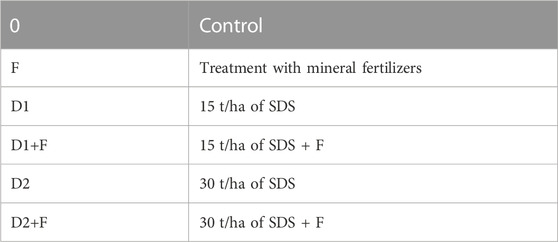Assessment of the agronomic value of solar-dried sludge and heavy metals bioavailability based on the bioaccumulation factor and translocation index
- 1Agricultural Innovation and Technology Transfer Center (AITTC), Mohammed VI Polytechnic University, Benguerir, Morocco
- 2College for Sustainable Agriculture and Environmental Science, Mohamed VI polytechnic University, Benguerir, Morocco
- 3Laboratory of Microbial Biotechnologies, Agrosciences and Environment (BioMAgE) Labeled Research Unit-CNRST N°4, Cadi Ayad University, Marrakesh, Morocco
This study aimed to assess the agronomic value of solar-dried sludge (SDS) and the transfer of Cr, Ni, Pb, and Cu to wheat (Triticum aestivum) and faba bean (Vicia faba). A greenhouse experiment was performed involving two rates of SDS (15 t/ha and 30 t/ha) from an activated sludge-based wastewater treatment plant. In addition to the single use of an SDS amendment, co-application of SDS and mineral fertilizers was also included to determine the best scenario resulting in high yields and less negative implications on the environment. Data for both wheat and faba bean showed that applying SDS at 30 t/ha led to competitive yields compared to the ones obtained previously, while 15 t/ha of SDS and mineral fertilizers were co-applied. The use of SDS increased soil organic matter, slightly decreased the pH value, and increased soil salinity. The contents of Ni, Cu, and Pb were not significantly affected by the application of SDS. Only Cr showed high soil concentrations in proportion to the increasing rates of SDS. The bioaccumulation of heavy metals in roots was more important in 30 t/ha than that in 15 t/ha amended soil. In the case of wheat, the bioconcentration factor (BCF) root values correspond to the following order: Cr (0.89) >Cu (0.85)> Ni (0.28)> Pb (0.22). In the case of faba bean, BCF roots were observed as follows: Cu (1.04 > Ni (0.37)> Cr (0.16)> Pb (0.15). Wheat excluded Cr, Ni, and Pb from the uptake by shoots, and Cu was translocated from roots to shoots with a percentage of 11% at 30 t/ha of applied SDS. Faba beans demonstrated more important values of HM’s translocation by respecting this order (Ni (37.7%) > cu (30.24%)> Cr (17.59%), while Pb was excluded from the translocation. No significant difference was observed regarding the translocation index when the sludge rate has been duplicated from 15 t/ha to 30 t/ha. Based on these outcomes, SDS used at the rate of 30 t/ha is the best scenario to amend the soil and provide nutrients to plants. Wheat is translocating less heavy metal to the edible part; it is, thus, the most suitable crop to be involved in the current context.
1 Introduction
Due to the rapid population growth, which is estimated to reach 9 billion by 2050 (WPP, 2017), ensuring food security around the world has become a challenge. To deal with this concern, yields have been improved through crop intensification, inducing soil quality degradation. This intensification involves an excessive use of mineral fertilizers and results in organic matter depletion of soils. Moreover, intensified agriculture with conventional tillage affects soil’s structural stability and increases its vulnerability to erosion. According to Rasmussen et al. (1998), conventional tillage practices can reduce soil organic carbon at the top 7.5 cm of a soil by 25%–30%. Thus, meeting the global food demand without affecting soils, associated resources, and the environment, while moving food and agricultural systems toward sustainability, has become an urgency. Indeed, sustainable agricultural intensification was suggested to achieve more food, produced from the same land, reducing negative environmental impacts, and then, providing positive societal and economic benefits.
On the other hand, sewage sludge production is being increased proportionally to the widespread adoption of advanced technologies of wastewater treatment. The management of such a byproduct, without negative implications on the environment, constitutes a major concern for all the stakeholders including researchers from all fields. Several practices have been adopted for sewage sludge final disposal such as landfilling, incineration, and application on agricultural soils, while awareness about sewage sludge as a valuable resource is increasing. Therefore, landfilling started to phase out in many countries (Kroiss et al., 2007; Raheem et al., 2018) in parallel with the search for alternative ways of valorization.
Knowing that sewage sludge contains plant nutrients (N, P, and K among others) and more than 50% of organic matter, its use as an organic amendment and fertilizer can contribute to soil property enhancement and soil nutrient availability. This practice is crucial for Africa, mainly in arid and semi-arid regions, where soils have very low organic matter content (Albaladejo et al., 2013) and most crop residues are removed. For instance, in Morocco, the mean value of organic matter content is below 2% and the annual agricultural soil loss is estimated to 100 million tons (FAO, 2015). Thus, agricultural recycling of sewage sludge consists of a particular relevance for soil organic matter improvement and associated physical and chemical benefits. According to several research studies, incorporating sludge into agricultural soils leads to atmospheric CO2 concentration reduction and soil organic carbon increase. This may, consequently, contribute to carbon sequestration and improve soil fertility (Soriano-Disla et al., 2010). Indeed, the applied organic matter can be associated with clay to form the clay–humus complex, which promotes soil aeration and increases nutrients availability. However, to be applied on agricultural soils, sewage sludge should be neutralized and stabilized as it includes some hazardous materials, such as pathogens, heavy metals (HMs), and other organic micropollutants (Fijalkowski et al., 2017).
In the latest trends, with regard to the field of sewage sludge treatment, the solar-drying process is involved with particular emphasis, especially where solar radiation is available as it is the case in Morocco (3000 h/year of sunshine). Throughout the literature, the solar-drying process has been proven to not affect the agronomic value of sewage sludge (Lem et al., 2017; An-nori et al., 2020a; An-Nori et al., 2022). Moreover, its significant ability to remove pathogens, namely, indicators of fecal contamination and helminths, has been reported in several research studies (Shanahan et al., 2010; Paluszak et al., 2012; An-Nori et al., 2021). However, less information is available on the behavior of heavy metals in solar-dried sludge, especially in terms of bioavailability and transfer to plants. Furthermore, HM accretion within the comestible parts of crops is a limitation to sewage sludge application on arable soil (Eid et al., 2021). According to several authors, plant uptake is one of the major pathways by which the essential and non-essential HMs enter the food chain (Karami et al., 2009). The uptake of HMs by plants is influenced by numerous parameters including the physical and chemical characteristics of the soil, the sewage sludge composition and its application rate, plant species and their physiology, rhizosphere biochemistry, climatic parameters, HMs, and their speciation (Dolgen et al., 2007). Contrary to the bioaccumulation of HMs in root systems, translocation from roots to shoots is controlled mainly by plant physiology (Kalis et al., 2008; Chimie, 2014; Chopra, 2014). The concentration of HMs in roots has been widely used as an indication of metal bioavailability (Chaignon et al., 2003), while the concentration measured in shoots determines which fraction may potentially enter the food chain and undergo biomagnification, having concomitant impacts on human health and alterations to the environment.
Throughout the literature, several investigations focused on the composted sewage sludge application on agricultural soils. However, solar-dried sludge and its implications on crops’ yields and quality was not addressed, especially in Morocco. Additionally, the behavior and traceability of the included HMs in solar-dried sludge, after recycling in agriculture, is not yet addressed in the literature. In this study, we aimed to assess (i) the agronomic value of solar-dried sludge as an organic amendment on crop yields and (ii) HM transfer to different parts of wheat and faba bean crops.
2 Materials and methods
2.1 Solar-dried sludge characteristics
The solar-dried sewage sludge used in the present experiments has been sampled from the wastewater treatment plant (WWTP) of Marrakech city, which is an activated sludge-based WWTP. Before solar drying, the sludge was digested (37°C) and mechanically dewatered using belt filters and was then solar-dried for 45 days in summer under a semi-arid climate (An-nori et al., 2020a). Physicochemical analysis of solar dried sludge was performed in three replicates, in a previous investigation (An-nori et al., 2020a). The main characteristics of solar-dried sludge (SDS) are shown in Table 1.
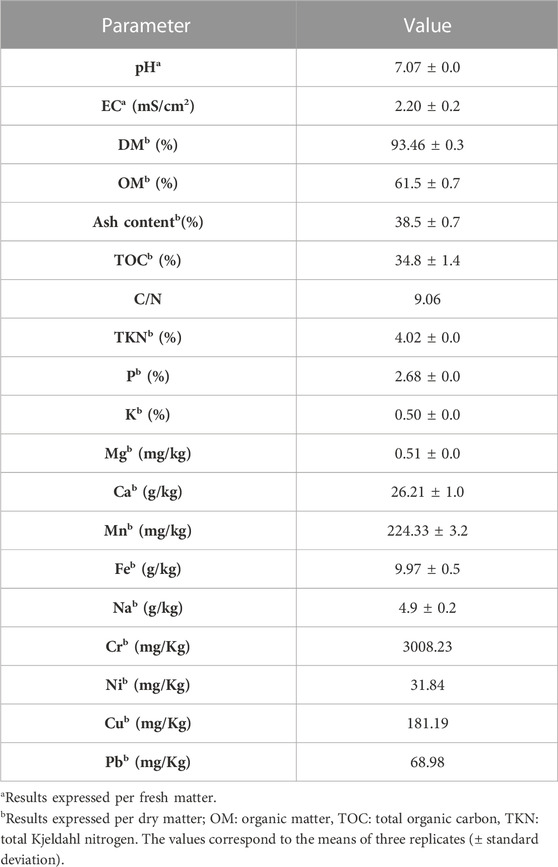
TABLE 1. Physicochemical characteristics of solar-dried sludge used as an organic amendment (An-nori et al., 2020a).
The used sewage sludge is an important source of organic matter (61.5%) and total nutrients (4%, 2.62%, and 0.5% of N, P, and K, respectively) (Table 1); thus, it can importantly be used as a fertilizer complement or a fertilizer depending on the rate of application. Regarding HM analysis, high concentrations of Cr, Ni, Cu, and Pb have been recorded (3008 mg/kg, 31.84 mg/kg, 181.19 mg/kg, and 68.98 mg/kg, respectively). In comparison with the international limits for agricultural use of SS, namely, the EC Directive 86/278/EEC (Supplementary Table S1), Cu, Ni, and Pb did not exceed these limits. As for Cr, it is only a few ppm above the maximum admitted load considered by the U.S. Environmental Protection Agency (Supplementary Table S1). However, the speciation analysis of this element in a previous investigation indicated low mobility potential of Cr (An-nori et al., 2020a). Indeed, the oxidizable fraction, which was initially predominant in the sludge before undergoing a solar drying process, decreased very significantly after 45 days of solar drying, and the residual fraction, the most stable in the environment, became the most important in SDS. This leads to the assumption that Cr may not be relatively bioavailable to plants. However, guidelines or limits are different from one country to another; they are based on the total content of metals in sewage, soil, and plant, and hence, more investigations are needed by integrating soil, plant, climate, and HM total content and speciation in solar-dried sludge to decide rationally on its safe use in agriculture.
2.2 Soil physicochemical characteristics
Samples from the 20 cm topsoil were collected from the experimental farm of UM6P in Ben Guerir, Morocco (31.6295° N, 7.9811° W). Soil samples were air-dried, mechanically grinded, and then sieved to obtain less than 2 mm fraction. Soil texture was determined by Robinson’s pipette method, and pH and electrical conductivity were measured on an aqueous extract of soil (1/10 w/v, distilled water, 30 min of shaking) (AFNOR NF T90-008). Equivalent calcium carbonate (CO32−) was determined by using the Bernard calcimeter (Hulseman, 1966). OM was determined by muffle calcination (600 C for 6 h). Total Kjeldahl nitrogen (TKN) was assayed in 0.5 g samples by using the classical Kjeldahl procedure by steam distillation according to the AFNORT90-110 standard. The content of HMs and major essential elements in the soil were determined after mineralization with tri-acid mixture (7 mL HNO3, 2 mL HF, and 1 mL HClO4) in the DigiPREP system (3 h at 120°C) (Hanay et al., 2008). After digestion, the solutions were filtered (0.45 µm mesh) and then diluted to 50 mL with distilled water. After digestion, the filtrates were acidified (2% HNO3) to undergo the analysis by inductively coupled plasma optical emission spectroscopy (ICP-OES) using the Agilent Technologies 5110 ICP-OES. All the physicochemical analyses were performed in triplicate, and all the chemicals used were of analytical reagent grade. Standards of soil and sewage sludge were used for quality control in the quantification of HMs. Soil analysis was performed before planting and after harvest. All the analyses were performed at the Agricultural Innovation and Technology Transfer Center laboratories of UM6P. The main characteristics of the used soil in the present investigation are shown in Supplementary Table S2.
2.3 Experimental design
Two agricultural trials were carried out in pots between January and May 2021 under greenhouse conditions at the experimental farm of Mohammed VI Polytechnic University (UM6P) in Ben Guerir, Morocco, involving two crops: faba bean (Vicia Faba) and wheat (Triticum aestivum). Six treatments have been used separately for both wheat and faba bean, as shown in Table 2. They consist of SDS rates with and without fertilizer complement and include a treatment having mineral fertilizers (F) only. The treatments were arranged in a randomized complete block design (RCBD), with four repetitions.
The applied F is equivalent to 50 kg N/ha, 20 kg P/ha, and 90 K kg/ha for wheat and 10 kg N/ha, 20 kg P/ha, and 40 K kg/ha for faba bean, and it was calculated based on soil N, P, and K availability tests. These two trials were set in 4 kg-sized plastic pots filled with 3 kg of soil and 1 kg of gravel, at their bottom, to allow water drainage. Ten wheat seeds were sown in each pot. As for faba bean, two seeds were rinsed using deionized water and germinated in the dark on moist filter paper for 48 h at 24 C prior to sowing. Irrigation was regularly carried out to maintain approximately 60% water holding capacity (Foster, 1995) during the whole cycle of faba bean and during the four first months for wheat.
2.4 Plant parameter measurements
2.4.1 Emergence percentage
The germinated seeds were counted after 2 weeks to calculate the emergence percentage (GP), as follows:
2.4.2 Chlorophyll content index
Chlorophyll is highly involved in photosynthesis, the process by which the plant makes carbohydrates. Photosynthesis is reported to be one of the most sensitive plant physiological processes, and it is known to be vulnerable to metallic stress. Hence, CCI values may be an indicator in case sludge induces phytotoxicity in the present experiments. Starting from 2 months after sowing, the CCI was measured in the vegetative stage, from the middle part of the five youngest leaves (n = 20) by using a CCM-300 chlorophyll meter (Hansatech instruments).
2.4.3 Yield and its components
At harvest, in each pot (n = 4), the total biomass yield, straw yield, grain yield, and thousand seed weight were determined for wheat. The harvest index (HI) was calculated as the ratio of grain yield over total above-ground biomass.
As for faba bean, the total biomass yield and grain yield were determined in each pot (n = 4).
2.5 Heavy metal analysis in plants
At the end of the growing cycle (5 months after sowing), the plants were harvested, threshed, and separated into straw roots and seeds. Roots were thoroughly rinsed with tap water followed by deionized water. Afterward, shoots and roots were dried at 40°C for 2 days until they reach a constant weight. For HM analysis in shoots and roots, samples (0.5 g) were mixed with 8 mL of HNO3 and 2 mL of H2O2 and placed in a hot plate at 100 °C until total evaporation of the extracting solvents. The mineralized material was recovered by the addition of ultrapure water and filtered with an ashless filter. The volume was adjusted to 25 mL with ultrapure water and acidified with 2% HNO3. The concentrations of metals in shoots and roots were determined by using the ICP-OES spectrophotometer from Agilent Technologies.
2.6 Bioconcentration factor and translocation index
The bioconcentration factor (BCF) represents the quotient of the concentration in plants and the concentration in soil of a given metal (Karami et al., 2009).
where Ctissue represents metal concentrations in the tissues of the plant (either above-ground or underground organs) and Csoil represents metal concentrations in soil (Ali et al., 2013). The metal concentrations in the extracts of the soil and plants were calculated based on dry weight.
2.6.1 Translocation index
where Cshoots represents metal concentrations in the tissues of organs above-ground plant (mg/Kg) and Croots represents metal concentrations in the tissues of the plant roots (mg/Kg) (Marchiol et al., 2004).
2.7 Statistical analysis
Soil physicochemical properties, yield components, HM concentrations in different plant organs, and the BCF and TI were used as variables to test the effects of sludge and/or fertilizer application on wheat and faba bean. The impact of different treatments on the studied variables was analyzed using the one-way analysis of variance (ANOVA) using SPSS 20 software. When the ANOVA null hypothesis was rejected, Tukey’s test at p < 0.05 was performed to determine significant differences among means.
3 Results and discussion
3.1 Physiological assessment of plant growth
3.1.1 Wheat emergence percentage
The emergence percentage of wheat is shown in Figure 1; an average of 90% was recorded. No significant difference was observed between different treatments. This is likely due to the fact that this stage of plant growth, including germination and emergence, does not require nutrients and organic matter existing initially in the soil and provided by SDS and fertilization. In fact, seed germination is known to be vulnerable to metal phytotoxicity (Amin et al., 2013) and high salt concentration in case of high fertilizer application (especially the one containing nitrogen). The current results indicate that SDS incorporation into the soil did not induce any phytotoxicity in seeds during the germination stage. Despite its high content in the incorporated sludge (3008.23 mg/kg), chromium had no effect on the germination process.
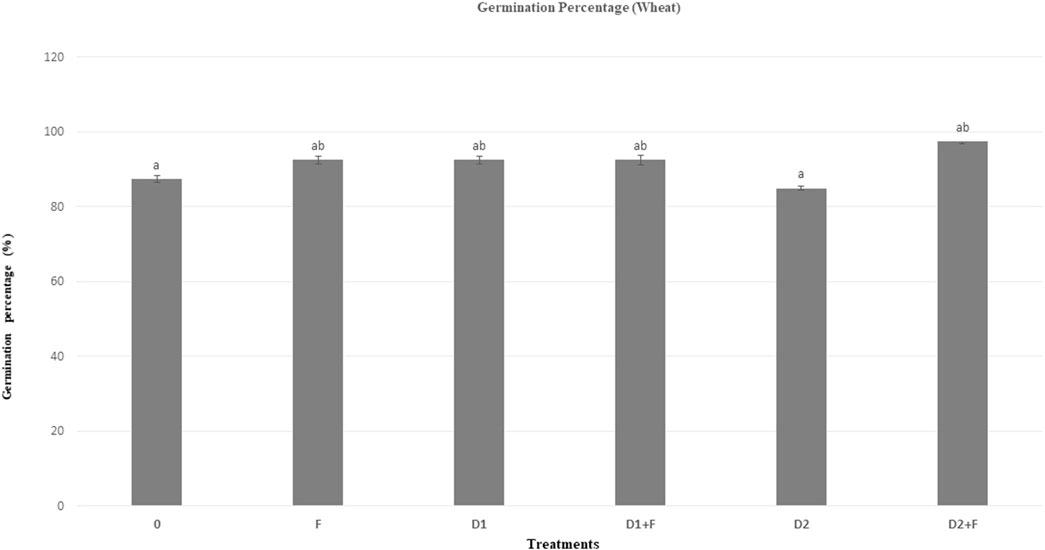
FIGURE 1. Emergence percentage of wheat. Results are the mean of four replicates. Bars represent standard errors (n = 4). Means with the same letter are not significantly different at (p < 0.05).
3.1.2 Chlorophyll content index
Chlorophyll content showed a significant difference between different treatments for wheat (Figure 2A). The application of SDS separately or in combination with fertilizers significantly increased wheat’s CCI when compared to the control and applied fertilizers alone (F). However, there was no significant difference between SDS treatments and the control and mineral-fertilized soils (Figure 2A). Our data are in agreement with Pascual et al. (2008), who found increased photosynthesis in pepper plants amended with digested sewage sludge compared to the control plants. This may be due to the nitrogen input, which was higher in SDS than the mineral fertilizer since chlorophyll content is approximately proportional to leaf nitrogen content (Evans, 1983; Bojovi and Markovi, 2009). In fact, the equivalent of 4% nitrogen rate in SDS in the two used rates (15 t/ha and 30 t/ha) exceeded the amount of nitrogen provided by the mineral fertilizer (50 kg/ha).

FIGURE 2. Chlorophyll content index measured in plants under different treatments: (A) wheat and (B) faba bean. Means with the same letters are not significantly different at p = 0.05.
In the case of faba bean, there was no significant difference between all the treatments involving both mineral fertilizers and organic amendments (Figure 2B). Compared to wheat, faba bean presented an important value of CCI even for the control. The difference between wheat and faba bean in terms of the CCI pattern is likely due to the physiological difference between the two species. Indeed, due to its biological nitrogen fixation capacity, faba bean, like other food legumes, can fix the atmospheric nitrogen and convert it into ammonia that can be used for its growth (Fan et al., 2006).
Chlorophyll content in plants is among the symptoms related to heavy metal phytotoxicity. Several authors attributed chlorosis to a high concentration of Cr in soil (Amin et al., 2013; Mahdi, 2015). In the present context, considering the CCI increase due to SDS use as an organic amendment, it can be concluded that SDS did not induce phytotoxicity in both faba bean and wheat. This leads to the assumption that either the included metals in SDS were not available in plants or the applied rates were probably not high enough to induce phytotoxicity.
3.2 Yield assessment
The chemical composition of the sewage sludge used in the experiments (shown in Table 1) indicates that this material is an important source of organic matter and nutrients for agricultural soils, which justified its use as a fertilizer (Figure 3). Harvest index, biomass, straw, and grain yields were calculated for wheat in order to assess the agronomic added value of the applied SDS. The application of sewage sludge had significantly increased the total biomass production proportionally to the rate of sludge (160 qx/ha) instead of almost 50 qx/ha recorded in the control. As for straw, the recorded yield increased very significantly when SDS rate increased. 80 qx/ha was measured for the 30 t/ha applied sewage sludge compared to 60 qx/ha linked to the 15 t/ha of applied sludge and 40 qx/ha for the control. Furthermore, the co-application of chemical fertilizers and SDS at a rate of 15 t/a resulted in an important increase of both biomass and straw yields (Figure 3). However, no significant difference between the combined application of SDS and fertilizers and the single use of SDS was observed, especially when the application rate was high (30 t/ha). This leads to conclude that SDS application with an important rate may satisfy the needs of the plants in terms of nutrients. Hence, applying SDS on agricultural soils may contribute to limit the overuse of mineral fertilizers and then reduce their related cost and potential negative impacts on the environment.
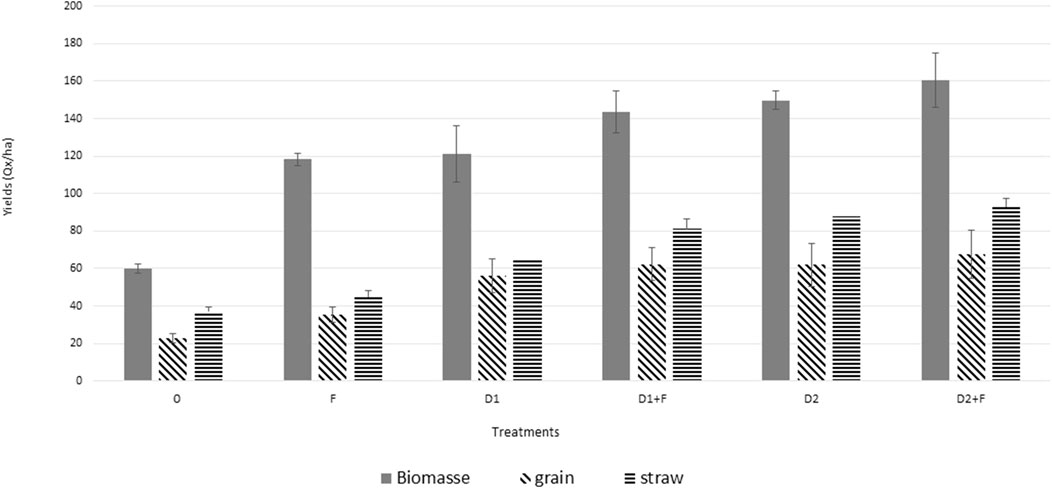
FIGURE 3. Biomass yield (qx/ha), straw yield (qx/ha) and grain yield. Results are mean of 4 replicates. Bars represent standard errors (n = 4).
The two rates of SDS and F enhanced the harvest index but without being significantly different from the control (Figure 4). The 1000 grain weight was not significantly affected by SDS, F, and their combination (Figure 4B). These outcomes helped understand that the applied treatments did not affect the yield quality.
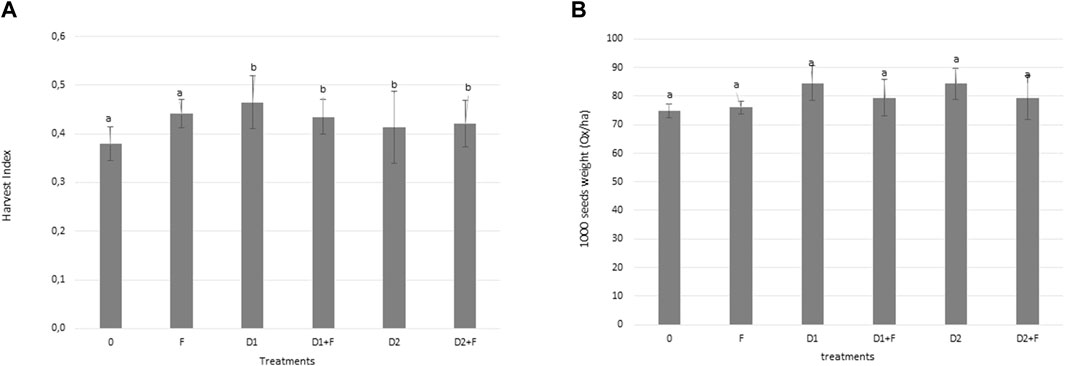
FIGURE 4. Harvest index evolution accordingly in the conduced treatments. Results are means of four replicates. Bars represent standard errors (n = 4). Letters indicate significant differences between treatments (p < 0.05).
The total biomass production and grain yield of faba bean are shown in Figure 5. Biomass yields were enhanced with the use of SDS as an organic amendment (Figure 5A). However, increasing the SDS application rate did not induce a significant effect on the biomass yield. The co-application of 30 t/ha SDS and mineral fertilizers provided the most important biomass yield with a significant difference when compared to other treatments. The single use of mineral fertilizers, when compared to the control, did not affect the biomass, but it significantly increased the grain yield over the control (Figure 5B). The co-application of 30 t/ha SDS with mineral fertilizers allowed an important grain yield (equivalent to 21.65 qx/ha).

FIGURE 5. (A) Biomass yielld and (B) grain yields for faba beans in the different conducted treatments. Results are means of four replicates. Bars represent standard errors (n = 4). Means with the same letters are not significantly different at p < 0.05.
Overall, sewage sludge application on agricultural soil increases crop production due to its high nutrient content, as demonstrated previously by several investigations (Latare et al., 2014; Samara et al., 2017; Eid et al., 2019). The present study showed that there is a trend of production increase while increasing the rates of sludge and demonstrated that an important rate of sludge without the addition of mineral fertilizers can support plant growth and development, which may reduce fertilizer applications to soil. However, the impact on soil properties, mainly the HM content, must be controlled according to the existing guidelines.
3.3 Soil physicochemical properties after harvest
The SDS application as an organic amendment increased the EC of the soil. Furthermore, after faba beans are harvested in the 30 t/ha amended pots, it reached 1.20 ms/cm compared to 0.87 ms/cm in the control. After wheat harvesting, the 30 t/ha of the applied SDS increased the EC up to 0.95 ms/cm against 0.53 ms/cm in the control (Table 3). Such observations may be explained by the high salt load brought by SDS to soil. Our findings are in accordance with Epstein E (1975), Chopra et al., and Samara et al. (2017), who reported increasing soil salinity while incorporating SDS as an organic amendment. However, it is worth emphasizing that the measured EC within the 30 t/ha amended soil reached neither the critical limit for sensitive field crops (2 mS/cm) nor the limit detrimental for most field crops (4 mS/cm) (Brady and Weil, 2008).

TABLE 3. Physicochemical characteristics of the post harvested soil and heavy metals accumulation after solar-dried sludge application. Values are means of four replicates. Letters indicate significant differences between treatments (p < 0.05).
In our investigation, soil OM increased with the rate of SDS addition, achieving its highest value with the maximum dose (30 t/ha). After faba bean harvesting, OM reached 4.04% instead of 1.8% in the control. After wheat harvesting, soil OM reached 3.28% compared to 1.29% in the control. These findings support the existing literature, which previously reported increases of soil organic matter upon addition of sewage sludge (Samaras et al., 2008; Heras et al., 2009; Carbonell et al., 2011; Rafael et al., 2011). These observations in terms of OM elevation due to SDS is for a significant relevance, especially in arid and semi-arid countries, such as Morocco, where soils are poor in OM. Regarding soil pH, a slight decrease was observed in the SDS-amended pots and the control for both crops. After faba beans were harvested in the 30 t/ha amended pots, pH reached 8.97 compared to 8.54 in the control. After wheat harvesting, pH is 8.54 in soil subjected to 30 t/ha of SDS compared to 8.73 to in the control (Table 3). Throughout the literature, some studies reported that sewage sludge incorporation into soil leads to an increase in soil pH. For instance, Samara et al. (2017) reported a significant increase in pH while incorporating limed sewage sludge (pH = 10). Others highlighted a decrease in pH while involving sewage sludge as an organic amendment. In fact, pH depends on the initial soils’ pH, the buffering capacity of the soil, and the pH of the used sewage sludge (Garrido et al., 2005; Fawy et al., 2018). In the current study, soil pH was almost two units higher than SDS’s pH. Hence, we can assume that the slight decrease in soil pH after SDS application is due to its buffering capacity. Moreover, these observations may also be attributed to the mineralization of organic nitrogen added by SDS, which produces protons by the nitrification process (Eid et al., 2019). As for nutrient content, they increased with the increasing rates of the applied SDS in soil under faba bean and wheat crops. Concentrations of HMs such as Cr, Cu, Pb, and Ni increased due to SDS application (Table 3). Particularly, a significant level or content of Cr resulted from SDS application for faba beans (141 mg/kg) and wheat (92 mg/kg) when compared to the negative control under faba beans and the one under wheat (25.47 mg/kg and 26.50 m/kg, respectively). However, the accumulated HMs (Cr, Ni, Pb, and Cu) in soil remain under the maximum permissible values (Supplementary Table S3) set by the commission of the European Communities directive (commission of the European Communities 1986).
3.4 Transfer of heavy metals from solar-dried sludge-amended soil to faba bean and wheat
Figure 6 shows the concentrations of Cr, Ni, Pb, and Cu in shoots and roots of wheat according to the conducted treatments. It can be observed that excluding Cu, the concentration of these metals were under the quantification limit in wheat’s shoots. However, high values were recorded in roots which seemed to be in accordance with Karami et al. (2009) and Mazen et al. (2010), who concluded that metals accumulated mostly in roots rather than in other wheat tissues. Figure 6A shows the concentrations of Cr that are markedly higher in roots than shoots. The concentration of Cr in roots increased significantly when sludge rate increased (91.45 mg/kg and 14.28 mg/kg at 30 t/ha and 15 t/ha applied SDS, respectively). In addition, the combination of SDS and mineral fertilizers resulted in a significant increase of Cr uptake by roots (146 mg/kg against 59.74 mg/kg in the D2+F and D1+F treatments, respectively).
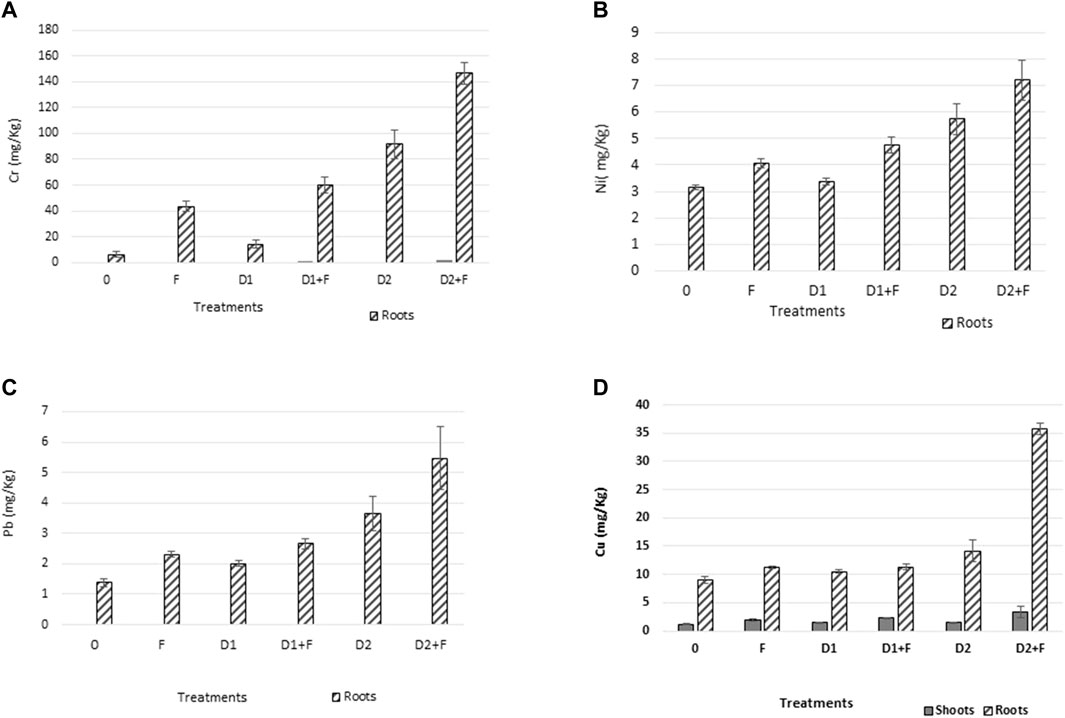
FIGURE 6. Concentration of metals in shoots and roots of wheat in the different conducted treatments: (A) Cr, (B) Ni, (C) Pb, and (D) Cu. Results are means of four replicates. Bars represent standard errors (n = 4).
Ni showed the same pattern within the used treatments; an increase in root concentration was recorded when the SDS rate increased (5.7 mg/kg and 3.37 mg/kg when SDS was applied at 15 t/ha and 30 t/ha, respectively). The combined application of SDS and mineral fertilizers increased Ni concentration from 4.76 to 7.21 mg/kg. Figure 6C shows a slight increase in Pb root concentrations when the SDS rate increased (2.01 mg/kg against 3.66 mg/kg). Contrary to the previously reported metals, copper content in shoots was high enough to be quantified through plant analysis. However, shoot concentrations remained very low when compared to those of roots (3.41 mg/kg in shoots against 35.45 mg/kg in roots within the D2+F treatment). Figure 6D shows that Cu concentration increased in both shoots and roots when the SDS rate increased. Additionally, a significant increase in Cu concentration in roots was recorded while involving mineral fertilizers with the 30 t/ha of SDS.
Contrary to wheat, Figure 7 shows that Cr, Cu, and Ni have been quantified in faba bean’s shoots although their concentrations remain less important than those measured in roots. Lead was not quantified in faba bean’s shoots, but an important concentration was recorded in roots (Figure 7C). The concentrations of Cr, Cu, and Ni in roots increased with the increase in SDS rates. Moreover, a significant difference was observed between the single application of SDS and its co-application with mineral fertilizers in terms of HM concentration in faba bean roots. Copper concentration in roots also showed a very significant difference among the applied treatment. An average concentration of 45 mg/kg was measured when 30 t/ha of SDS and mineral fertilizers were applied together (Figure 7D).
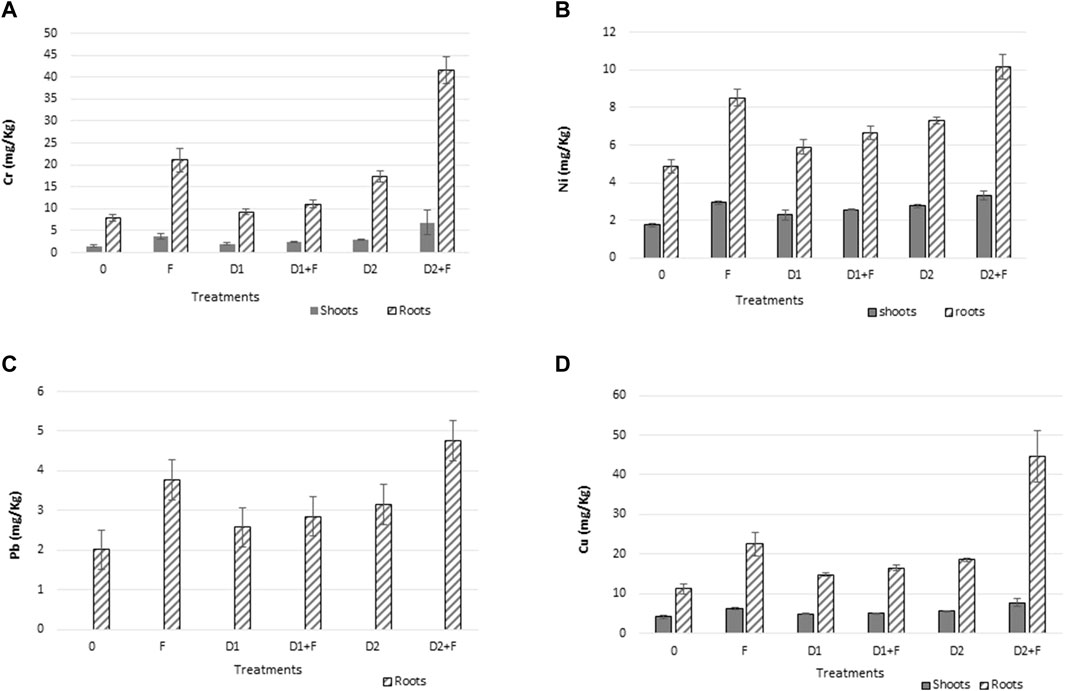
FIGURE 7. Concentration of metals in shoots and roots of faba beans in the different conducted treatments: (A) Cr, (B) Ni, (C) Pb, and (D) Cu. Results are means of four replicates. Bars represent standard errors (n = 4). Letters indicate significant differences between treatments (p < 0.05).
From the aforementioned results, it can be assumed that the increase of metal contents, mainly in roots when the SDS rate increased, is likely due to the additional concentrations of these metals brought to the soil by SDS, as demonstrated previously by several authors (Bose and Bhattacharyya, 2008; Soriano-disla and Gómez, 2014; Eid et al., 2019). Moreover, this may be a consequence of an interesting root development enhanced by the nutrient input of the applied SDS as an organic fertilizer.
3.5 Bioaccumulation and phytoextraction assessment of heavy metals by wheat and faba bean
3.5.1 Bioaccumulation of metals assessed by the bioconcentration factor
The previously presented data emphasized that the roots exhibited markedly elevated heavy metal concentrations compared to the above-ground plant components. In order to assess more accurately the HM uptake by roots, bioaccumulation is a commonly involved concept. Bioaccumulation defines the ability of the plant tissue to accumulate HMs, while allowing for their initial substrate content (Pachura et al., 2015). In other words, the higher the content of metal is in soil, the higher the concentration of the element is observed in plant tissues. As a basis for HM’s bioaccumulation assessment, the BCF is commonly used (Guo-hang et al., 2018; Eid et al., 2021). The four-degree scale described by Michałowski and Gołas (2001) and Pachura et al. (2015) was adopted. If the BCF >1, the plants have accumulated elements, and the ratios around 1 indicate that the plants are not influenced by the elements, and a BCF <1 shows that plants exclude the elements from the uptake (Soriano-disla and Gómez, 2014; Agic et al., 2015). If the plants have higher BCF values, they can be used for soil remediation.
The previously described results compare well with BCF values, as shown in Table 4. BCF shoots for wheat in all the conducted treatments helped understand that the above-ground part of wheat does not accumulate metals. However, in the case of faba beans, in the non-amended trial (absence of SDS), BCF shoots also meant that faba beans did not accumulate metals in the shoots. However, BCF values showed medium bioaccumulation of Cu in shoots but a high bioaccumulation of that metal in roots for both wheat and faba beans. When SDS is applied at 30 t/ha, a high bioaccumulation of Cr in roots was observed. As for Pb, medium bioaccumulation in roots was recorded for both wheat and faba beans. A significant difference in terms of the bioaccumulation of the studied HMs in roots was observed between the single use of SDS and the combined treatment involving SDS and mineral fertilizers.
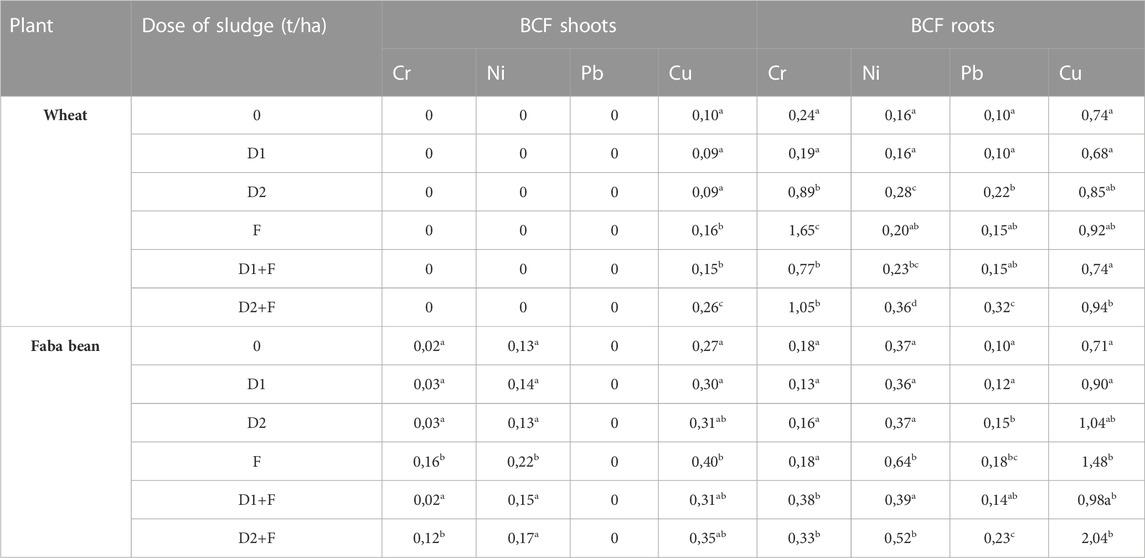
TABLE 4. Bioconcentration factor for roots and shoots in wheat and faba beans under the different treatments. Values are means of four replicates. Letters indicate significant differences between treatments (p < 0.05).
The current data demonstrated that the assayed HMs were in a higher concentration within the root system than in the above-ground plant components (shoots). This compared well with the literature as the root system has been demonstrated to be the principal site of accumulation of HMs because of their high binding affinity in this type of tissue (Karamooz et al., 2016). Roots behave as a filter with respect to the uptake of HMs, acting, thus, as an obstruction to their absorption or decelerating their passage to shoots (Ahmed et al., 2018; Eid et al., 2021). Moreover, the plants have a range of processes that enables them to deal with the presence of HMs in the substrate. For instance, binding the metals to the root cells and/or sequestering them in vacuoles are among the tools by which the active regions of the cells are kept away from HMs (Zhou et al., 2015).
The metal concentration in roots is known to be highly related to the metal speciation in the soil solution (Yang et al., 2019). Prior to this study, we have assessed HM speciation in SDS. We have demonstrated, through a BCR scheme, a low mobility of the studied HMs (Cr, Ni, Pb, and Cu) since the residual fraction was found to be predominant compared to the exchangeable, reducible, and oxidizable ones (An-nori et al., 2020a). Although the recorded results in the present study regarding BCF roots seemed to be in accordance with the speciation results, it may be more rational to investigate HM speciation in the soil solution, after the incorporation of SDS, to explain the mechanisms behind the bioaccumulation of HMs in the root system.
3.5.2 Phytoextraction of metals assessed by the translocation index
The translocation index (TI) is a measure of the phytoextraction capacity of plants. It indicates the efficiency of the internal translocation of HMs from the root system to the stems, leaves, and fruits (Marchiol et al., 2004). This transfer is governed by a number of factors but mostly by the plant, its physiology, and its water transport system (Kalis et al., 2008). By analyzing the values of the TI for both faba beans and wheat (Table 5), Cu was most importantly translocated into shoots among the studied metals. Moreover, the translocation of Cu was more important in faba beans compared to wheat. As for Cr and Ni, they were not translocated into wheat shoots within the conducted treatments. Pb was excluded from translocation in both wheat and faba beans. This means that the mobility of lead in the root-above-ground part system is very low, as demonstrated previously by Pachura et al. (2015). The translocation index of Cr increased proportionally to the increasing rate of SDS (30 t/ha). The significant increase in the TI when mineral fertilizers were used (20% instead of 10% in non-amended pots and 40% instead of 19% in the amended ones) helped understand that the use of mineral fertilizers increased the translocation values of Cr in the root-above-ground part system of both wheat and faba beans. This is likely due to the root-above-ground part system development, which was enhanced when SDS and mineral fertilized were co-applied to soil. Overall, despite being enhanced by the co-application of SDS amendment and the mineral fertilizers, the recorded values of the TI for both wheat and faba beans in all the conducted treatments remain far less than 100%.
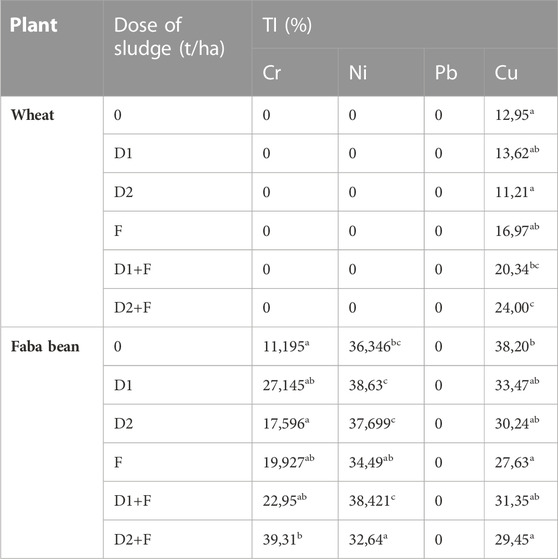
TABLE 5. Translocation index in wheat and faba beans under the different treatments. Values are mean of four replicates. Letters indicate significant differences between treatments (p < 0.05).
Knowing that the phytoextraction is likely to be related to the plant physiology, it can be assumed from the aforementioned data that faba bean involves phytoextraction mechanisms more than wheat. Since the translocated metal into shoots (the edible part) is most likely to cause health issues, it can also be concluded that wheat may be more suitable to be grown in an SDS-amended soil.
4 Conclusion
The present study markedly reveals the important added value of SDS in terms of agronomic yields of both faba beans and wheat. The crop production increased with the increasing rates of SDS. The use of SDS as an organic amendment showed competitive results in terms of biomass and grain yields compared to the single use of mineral fertilizers. The chlorophyll and germination percentage assessments did not indicate any phytotoxicity associated to SDS. Regarding soil properties, the use of SDS as an organic amendment enhanced soil organic matter, slightly decreased pH, and increased electrical conductivity. The contents of Ni, Cu, and Pb were not significantly affected by the application of SDS as an organic amendment. Only Cr showed increased concentrations in soil proportionally to the increasing rates of SDS, but the recorded concentrations remained under the limits set by the U.S. Environmental Protection Agency. The bioaccumulation of the studied HMs assessed by the BCF showed higher values in roots compared to shoots. When SDS is applied at 30 t/ha, it resulted in medium bioaccumulation of Cr in roots in both wheat and faba beans. When 30 t/ha of SDS was co-applied with mineral fertilizers, high bioaccumulation of Cr was observed. The phytoextraction assessment showed that wheat excluded Cr, Ni, and Pb from the translocation and only Cu was found to be translocated into the above-ground part. On the contrary, faba beans translocated HMs to the above-ground part except Pb. All the translocation index values were far less than 100%. Neither SDS rates nor mineral fertilizers affected the translocation index values for both faba beans and wheat. Furthermore, this may be recommended more in the present context as the edible part did not include HMs. On the basis of the present study, it appeared that the risk associated to SDS regarding HM uptake by wheat and faba bean tissues can be considered less significant than its agronomic value and its positive effects on soil fertility. Therefore, it is recommended in the present context to use SDS at 30 t/ha as the best scenario to amend the soil and provide nutrients to plants. As a perspective to this study, a long-term field monitoring must be engaged in order to assess the long-term effect of SDS application on soil quality and the related implications on the environment.
Data availability statement
The original contributions presented in the study are included in the article/Supplementary Material, further inquiries can be directed to the corresponding author.
Author contributions
Conceptualization was completed by AA-n and MH. Methodology was created by AA-n. Software and research activities were handled by AA-n. Original draft preparation was handled by AA-n, while writing—corrections and editing were completed by KE, LE, DT, AE, ME, and MH and supervision was conducted by MH.
Funding
This study was financially supported by the Sustainability Platform (OCP Group), as part of the AS146 “Physicochemical and microbiological characterization of sewage sludge for agricultural recycling.” The funder was not involved in the study design, collection, analysis, interpretation of data, the writing of this article, or the decision to submit it for publication.
Acknowledgments
The authors would like to thank Mohammed VI Polytechnic University (UM6P) and the OCP group for their technical and financial support. They would also like to thank the experimental farm and the laboratory teams of the Agricultural Innovation and Technology Transfer Center (AITTC).
Conflict of interest
The authors declare that the research was conducted in the absence of any commercial or financial relationships that could be construed as a potential conflict of interest.
Publisher’s note
All claims expressed in this article are solely those of the authors and do not necessarily represent those of their affiliated organizations, or those of the publisher, the editors, and the reviewers. Any product that may be evaluated in this article, or claim that may be made by its manufacturer, is not guaranteed or endorsed by the publisher.
Supplementary material
The Supplementary Material for this article can be found online at: https://www.frontiersin.org/articles/10.3389/fenvs.2023.1163422/full#supplementary-material
Abbreviations
SDS, solar-dried sludge; WWTP, wastewater treatment plant; FAO, Food and Agriculture Organization; HMs, heavy metals; AFNOR, Association Française de Normalisation; TKN, total Kjeldahl nitrogen; ICP-AES, inductively coupled plasma atomic emission spectrometry; RCBD, randomized complete block design; GP, germination percentage; CCI, chlorophyll content index; HI, harvest index; BCF, bioconcentration factor; and TI, translocation index.
References
Agic, R., Milenkovic, L., and Ilic, Z. S. (2015). Transfer factor as indicator of heavy metals content in plants. Fresenius Environ. Bull. 24 (11), 4212–4219.
Ahmed, D. A., Slima, D. F., and Ahmed, D. A. (2018). Heavy metal accumulation by Corchorus olitorius L. irrigated with wastewater 14996–15005.
Albaladejo, J., Ortiz, R., Garcia-franco, N., Pintado, J. G., and Martínez-mena, M. (2013). Land use and climate change impacts on soil organic carbon stocks in semi-arid Spain. J. Soils Sediments 13, 265–277. doi:10.1007/s11368-012-0617-7
Amin, H., Arain, B. A., Amin, F., and Surhio, M. A. (2013). Phytotoxicity of chromium on germination, growth and biochemical attributes of Hibiscus esculentus L. Am. J. Plant Sci. 4, 2431–2439. doi:10.4236/ajps.2013.412302
An-nori, A., El Fels, L., Ezzariai, A., El Gharous, M., El Mejahed, K., and Hafidi, M. (2020a). Effects of solar drying on heavy metals availability and phytotoxicity in municipal sewage sludge under semi-arid climate. Environ. Technol. Innov. 19, 101039. doi:10.1016/j.eti.2020.101039
An-Nori, A., El Fels, L., Ezzariai, A., El Gharous, M., El Mejahed, K., Hafidi, M., et al. (2021). Effectiveness of helminth egg reduction by solar drying and liming of sewage sludge. Environ. Sci. Pollut. Res. 28, 14080–14091. doi:10.1007/s11356-020-11619-w
An-Nori, A., El Fels, L., EzzariaiEl Gharous, A. M., El Mejahed, K., and Hafidi, M. (2022). Solar drying as an eco-friendly Technology for sewage sludge stabilization: Assessment of micropollutant behavior, pathogen removal, and agronomic value. Front. Environ. Sci. 10. doi:10.3389/fenvs.2022.814590
Brady, N. C., and Weil, R. R. (2008). The nature and properties of soil. 14 ed. Upper Saddle River, NJ: Prentice-Hall.
Bojovi, B., and Markovi, A. (2009). Correlation between nitrogen and chlorophyll content in wheat (triticum aestivum l). 31, 69–74.
Bose, S., and Bhattacharyya, A. K. (2008). Heavy metal accumulation in wheat plant grown in soil amended with industrial sludge. Chemosphere 70, 1264–1272. doi:10.1016/j.chemosphere.2007.07.062
Carbonell, G., Miralles, R., Imperial, D., Torrijos, M., Delgado, M., and Antonio, J. (2011). Effects of municipal solid waste compost and mineral fertilizer amendments on soil properties and heavy metals distribution in maize plants (Zea mays L). Chemosphere 85, 1614–1623. doi:10.1016/j.chemosphere.2011.08.025
Chaignon, V., Sanchez-Neira, I., Herrmann, P., Jaillard, B., and Hinsinger, P. (2003). Copper bioavailability and extractability as related to chemical properties of contaminated soils from a vine-growing area. Environ. Pollut. 123, 229–238. doi:10.1016/s0269-7491(02)00374-3
Chimie, R. R. De (2014). Translocation of heavy metals from sewage sludge amended. SOIL PLANT 59, 81–89.
Chopra, V. K. A. K. (2014). Accumulation and translocation of metals in soil and different parts of French bean (Phaseolus vulgaris L.) amended with sewage sludge. Amend. Sew. Sludge 92, 103–108. doi:10.1007/s00128-013-1142-0
Eid, E. M., Alrumman, S. A., El-bebany, A. F., Fawy, K. F., Taher, M. A., Hesham, A. E., et al. (2019). Evaluation of the potential of sewage sludge as a valuable fertilizer for wheat (Triticum aestivum L.) crops. Environ. Sci. Pollut. Res. 26, 392–401.
Eid, E. M., Shaltout, K. H., Alamri, S. A. M., Alrumman, S. A., Hussain, A. A., Sewelam, N., et al. (2021). Prediction models based on soil properties for evaluating the uptake of eight heavy metals by tomato plant (Lycopersicon esculentum Mill.) grown in agricultural soils amended with sewage sludge. J. Environ. Chem. Eng. 9, 105977. doi:10.1016/j.jece.2021.105977
Evans, J. R. (1983). Nitrogen and photosynthesis in the flag leaf of wheat (Triticum aestivum L.) Plant Physiol. 72, 297–302. doi:10.1104/pp.72.2.297
Fan, F., Zhang, F., Song, Y., Sun, J., and Bao, X. (2006). Nitrogen fixation of faba bean (vicia faba L.) interacting with a nonlegume in two contrasting intercropping systems nitrogen fixation of faba bean (vicia faba L.) interacting with a non-legume in two contrasting intercropping systems 2016–2020. doi:10.1007/s11104-006-0019-y
FAO (2015). Boosting Africa’s Soils; from the Abuja Declaration on Fertilizers to a sustainable soil management framework for food and nutrition security in Africa by 2030.
Fawy, K. F., Taher, M. A., Hesham, A. E., Eid, E. M., El-bebany, S. A. A. A. F., and Ahmed, G. A. E. M. T. (2018). The evaluation of sewage sludge application as a fertilizer for broad bean (Faba sativa Bernh.) crops. Food Energy Secur. 7, e00142. doi:10.1002/fes3.142
Fijalkowski, K., Rorat, A., Grobelak, A., and Kacprzak, M. J. (2017). The presence of contaminations in sewage sludge – the current situation. J. Environ. Manage. 203, 1126–1136. doi:10.1016/j.jenvman.2017.05.068
Garrido, S., Campo, G. M. D. E. L., Esteller, M. V., Vaca, R., and Lugo, J. (2005). Heavy metals in soil treated with sewage sludge composting, their effect on yield and uptake of broad bean seeds (Vicia faba L.) Water, Air, Soil Pollutionh 166, 303–319. doi:10.1007/s11270-005-5269-4
Guo-hang, Y., Guang-yun, Z. H. U., He-lian, L. I., Xue-mei, H. A. N., Ju-mei, L. I., and Yi-bing, M. A. (2018). Accumulation and bioavailability of heavy metals in a soil-wheat/maize system with long-term sewage sludge amendments. J. Integr. Agric. 17, 1861–1870. doi:10.1016/S2095-3119(17)61884-7
Hanay, Ö., Hasar, H., Kocer, N. N., and Aslan, S. (2008). Evaluation for agricultural usage with speciation of heavy metals in a municipal sewage sludge. Bull. Environ. Contam. Toxicol. 81, 42–46. doi:10.1007/s00128-008-9451-4
He, Q., Ren, Y., Mohamed, I., Ali, M., and Hassan, W. (2013). Assessment of trace and heavy metal distribution by four sequential extraction procedures in a contaminated soil. Soil Water Res. 8 (2), 71–76. doi:10.17221/20/2012-SWR
Heras, J. D., Castro, E., and Man, P. (2009). A comparison of the application of different waste products to a lettuce crop: Effects on plant and soil properties. Eff. plant soil Prop. 123, 148–155. doi:10.1016/j.scienta.2009.08.013
Hulseman, J. (1966). An inventory of marine carbonate materials. J. Sediment. Petrol. 36 (2), 622–625. doi:10.1016/j.scienta.2009.08.013
Kalis, E. J. J., Temminghoff, E. J. M., and Riemsdijk, W. H. V. (2008). Relationship between metal speciation in soil solution and metal adsorption at the root. Surf. Ryegrass 2231, 2221–2231. doi:10.2134/jeq2007.0543
Karami, M., Afyuni, M., Rezainejad, Y., and Rainer, S. (2009). Heavy metal uptake by wheat from a sewage sludge-amended calcareous soil. Nutrient Cycl. Agroecosyst. 83, 51–61. doi:10.1007/s10705-008-9198-7
Karamooz, H., Akbar, S. A., Saeid, F. N., and Rainer, S. (2016). Tolerance and accumulation of heavy metals by Descurainia sophia L.
Kroiss, H., Zessner, M., Management, M., and View, C. B. (2007). Ecological and economical relevance of sludge treatment and.
Latare, A. M., Kumar, O., Singh, S. K., and Gupta, A. (2014). Direct and residual effect of sewage sludge on yield, heavy metals content and soil fertility under rice – wheat system. Ecol. Eng. 69, 17–24. doi:10.1016/j.ecoleng.2014.03.066
Lem, L., Collard, M., and Teychen, B. (2017). Comparison of three different wastewater sludge and their respective drying processes: Solar, thermal and reed beds. e Impact Org. matter Charact. 203, 760–767.
Mahdi, W. (2015). Influence of chromium metal on chlorophyll content in leaves of paddy oryza influence of chromium metal on chlorophyll content in leaves of paddy oryza sativa L.
Marchiol, L., Assolari, S., Sacco, P., and Zerbi, G. (2004). Phytoextraction of heavy metals by canola (Brassica napus) and radish (Raphanus sativus) grown on multicontaminated soil. Environ. Pollut. 132 (1), 21–27. doi:10.1016/j.envpol.2004.04.001
Mazen, A., Faheed, F. A., and Ahmed, A. F. (2010). Study of potential impacts of using sewage sludge in the amendment of desert reclaimed soil on wheat and jews mallow plants. Soil Wheat Jews Mallow Plants 53, 917–930. doi:10.1590/s1516-89132010000400022
Michałowski, M., and Gołas, J. (2001). The contents of selected heavy metals of willow organs as an indicator of their use in sewage sludge utilization. Workbooks Basic Prob. Agric. Sci. 477, 411e419.
Pachura, P., Ociepa-kubicka, A., and Skowron-grabowska, B. (2015). Assessment of the availability of heavy metals to plants based on the translocation index and the bioaccumulation factor Assessment of the availability of heavy metals to plants based on the translocation index and the bioaccumulation factor. Desalin. Water Treat. 57, 1469–1477. doi:10.1080/19443994.2015.1017330
Paluszak, Z., Skowron, K., Sypuła, M., and Skowron, K. J. (2012). Microbiological evaluation of the effectiveness of sewage sludge sanitization with solar drying technology. Int. J. Photoenergy 2012, 341592. doi:10.1155/2012/341592
Pascual, I., Avilés, M., and Aguirreolea, J. (2008). Effect of sanitized and non-sanitized sewage sludge on soil microbial community and the physiology of pepper plants. Plant Soil 310, 41–53. doi:10.1007/s11104-008-9626-0
Rafael, J., Bueno, P., Berton, R. S., Dias, P., Chiba, M. K., Alberto, C., et al. (2011). Chemical and microbiological attributes of an oxisol treated with successive applications of sewage sludge, 1461–1470. 1.
Raheem, A., Singh, V., He, J., Dastyar, W., Dionysiou, D. D., Wang, W., et al. (2018). Opportunities and challenges in sustainable treatment and resource reuse of sewage sludge: A review. Chem. Eng. J. 337, 616–641. doi:10.1016/j.cej.2017.12.149
Rasmussen, P. E., Albrecht, S. L., and Smiley, R. W. (1998). Soil C and N changes under tillage and cropping systems in semi-arid Pacic Northwest agriculture. Soil tillage res. 47, 197–205. doi:10.1016/S0167-1987(98)00106-8
Samara, E., Matsi, T., and Balidakis, A. (2017). Soil application of sewage sludge stabilized with steelmaking slag and its effect on soil properties and wheat growth. Waste Manag. 68, 378–387. doi:10.1016/j.wasman.2017.06.016
Samaras, V., Tsadilas, C. D., and Stamatiadis, S. (2008). Effects of repeated application of municipal sewage sludge on soil fertility, cotton yield, and nitrate leaching. Agron. J. 100, 477–483. doi:10.2134/agronj2007.0162
Shanahan, E. F., Roiko, A., Tindale, N. W., Thomas, M. P., Walpole, R., and Ipek Kurtböke, D. (2010). Evaluation of pathogen removal in a solar sludge drying facility using microbial indicators. Int. J. Environ. Res. Public Health 7, 565–582. doi:10.3390/ijerph7020565
Soriano-disla, J. M., and Gómez, I. (2014). The transfer of heavy metals to barley plants from soils amended with sewage sludge with different heavy metal burdens. J. Soils Sediments 14, 687–696. doi:10.1007/s11368-013-0773-4
Soriano-Disla, J. M., Navarro-Pedreño, J., and Gómez, I. (2010). Contribution of a sewage sludge application to the short-term carbon sequestration across a wide range of agricultural soils. Environ. Earth Sci. 61, 1613–1619. doi:10.1007/s12665-010-0474-x
WPP (2017). “World populations prospects,” in Key findings and advance table (New York, NY, USA: United Nations), 1. [Google Scholar].
Yang, Y., Zeng, L., and Chen, L. (2019). Chemical speciation and bioavailability of cadmium and lead in the gray calcium soil. Environ. Pollut. Bioavailab. 31, 306–315. doi:10.1080/26395940.2019.1685908
Keywords: solar-dried sludge, organic amendment, heavy metal, uptake, toxicity, soil, wheat, faba bean
Citation: An-nori A, El Mejahed K, Fels LE, Touhami D, Ezzariai A, El Gharous M and Hafidi M (2023) Assessment of the agronomic value of solar-dried sludge and heavy metals bioavailability based on the bioaccumulation factor and translocation index. Front. Environ. Sci. 11:1163422. doi: 10.3389/fenvs.2023.1163422
Received: 10 February 2023; Accepted: 27 March 2023;
Published: 13 April 2023.
Edited by:
Jun Wu, Harbin Engineering University, ChinaReviewed by:
Chen Tu, Institute of Soil Science (CAS), ChinaS. Suresh, Sona College of Technology, India
Copyright © 2023 An-nori, El Mejahed, Fels, Touhami, Ezzariai, El Gharous and Hafidi. This is an open-access article distributed under the terms of the Creative Commons Attribution License (CC BY). The use, distribution or reproduction in other forums is permitted, provided the original author(s) and the copyright owner(s) are credited and that the original publication in this journal is cited, in accordance with accepted academic practice. No use, distribution or reproduction is permitted which does not comply with these terms.
*Correspondence: Amal An-nori, amal.an-nori@um6p.ma
 Amal An-nori
Amal An-nori Khalil El Mejahed
Khalil El Mejahed Loubna El Fels3,
Loubna El Fels3,  Amine Ezzariai
Amine Ezzariai Mohamed El Gharous
Mohamed El Gharous Mohamed Hafidi
Mohamed Hafidi